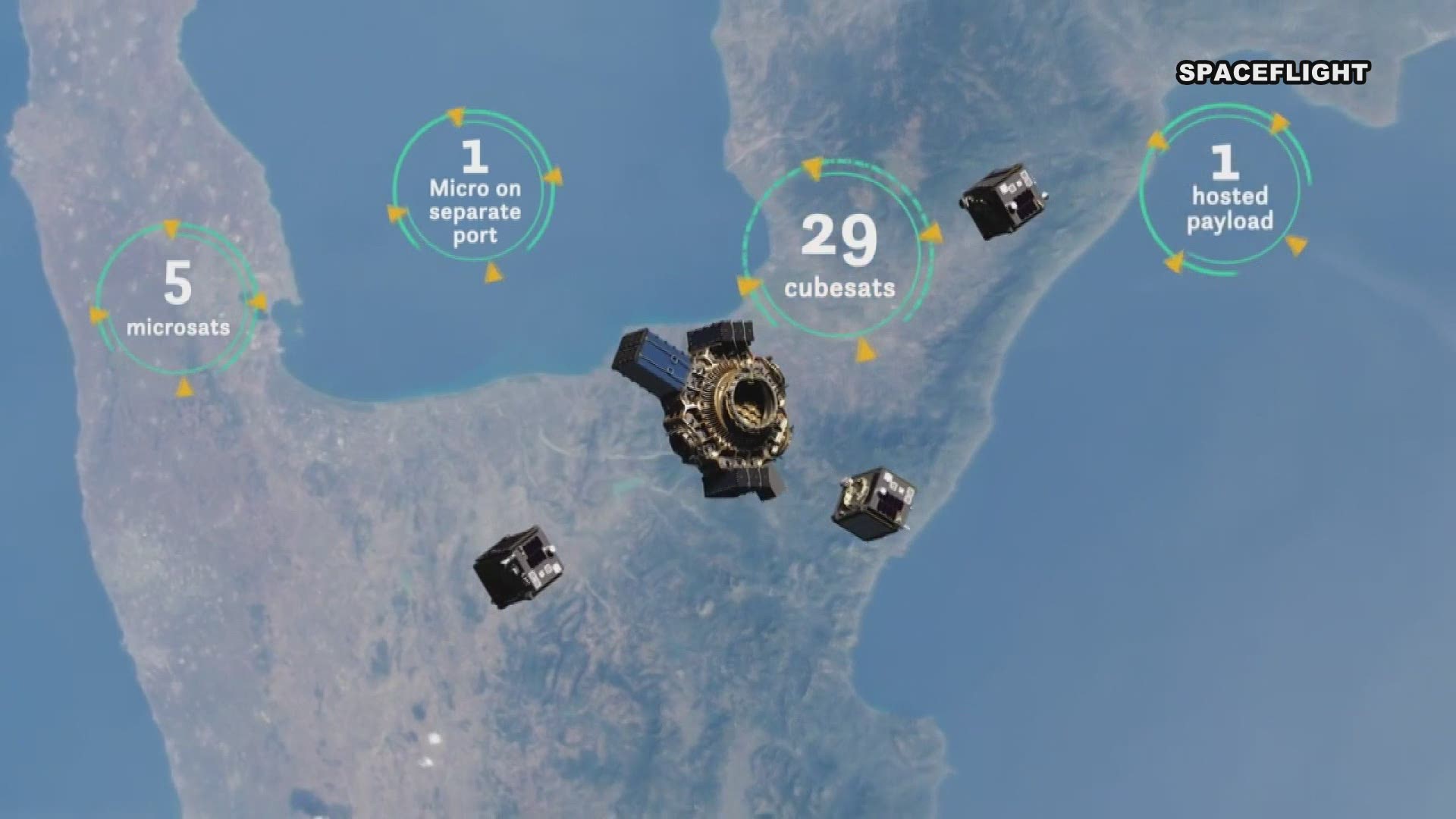AUBURN, Wash. — Spaceflight Inc.’s Auburn Integration Center is preparing its Sherpa Orbital Transfer Vehicles to launch 36 small satellites into orbit aboard the SpaceX Transporter-2 mission, which is scheduled to launch no earlier than June 2021.
The launch will include spacecraft from seven different countries.
The Orbital Transfer Vehicles, or OTVs, function like a rideshare or taxi cab and will deploy from SpaceX's Falcon 9 rocket.
Where the early days of space travel saw one giant satellite heaved into orbit aboard a single massive rocket, the size of the satellites is now much smaller, some are even tiny. The Sherpa ring holding individual boxes containing the satellites will put them into the correct orbit when ready.
The mission also represents the first time Spaceflight Inc. will fly two different OTVs and the launch of the industry's first-ever electric propulsion vehicle, the Sherpa-LTE1. Electric propulsion is considered slower, but more efficient and less hazardous than typical rocket fuels.


With 55 employees, Spaceflight Inc. is part of a growing space industry in Kent Valley and Washington state. It's an industry started back in the 1960s that included Boeing, which did much of the work for the Apollo moon missions in Kent.
Boeing has scaled back, but now Jeff Bezos' Blue Origin has entered the playing field and is expanding, as well as Spaceflight.
"We have about half of all the state’s space employment," said city of Kent Chief Economic Development Officer Bill Ellis. He said the last study the city has on space employment places 5,500 jobs just within Kent city limits, out of more than 11,000 direct space jobs in Washington state.
Further north in Redmond, Aerojet Rocketdyne started as a pioneer in the early 1960s and builds engines for many NASA and commercial space missions.
The city of Kent is planning to build a playground for kids starting in early 2022, and who knows what that could inspire.


The following is a list and quick notes from Space-related companies from the Washington Department of Commerce.
Industry Leaders
Aerojet Rocketdyne: Over the last 50 years the company has produced more than 19,000 thrusters in Washington, and boasts a 100% success rate. Their Redmond facility manufactures 200 to 500 thrusters a year, from tiny rockets to keep satellites properly positioned to ones rated at 600 pounds of thrust or more.
BlackSky: Provides an easy, affordable way to observe, analyze and act on timely and relevant insights using high-quality satellite images from multiple sources, combined with a diverse set of real-time sensor data such as news feeds, social media and radio communications.
Blue Origin: Performs engineering, design and production of rockets motors, the reusable New Shepard spacecraft and systems for its New Glenn rocket and Moon Lander.
Boeing: Provides Broadband SatCom Network operations, administration and management duties to global ground stations and design support for the Starliner crew capsule.
Carlisle Interconnect Technologies: Manufactures TVS, EMI, Filter, and RF/Microwave connectors for space and satellite applications.
Cobalt Enterprises: Builds satellite components.
Crane Aerospace & Electronics: Sensing systems, fluid management, landing gear systems and cabin components.
Electroimpact: Manufactures all forms of satellite fixtures, containers, trailers and tooling.
Helion Energy: Developing a magneto-inertial fusion technology for propulsion.
Janicki Industries: Manufactures production tooling and fly-away parts for spacecraft, including the Lower Pressure Dome of the Boeing Starliner.
Kymeta: Manufactures satellite antennas and communications technologies.
MSNW: Manufactures new space propulsion technology.
Off Planet Research: Research facility that simulates extra-terrestrial environments to test space systems to further research and development of cost-effective, safe and effective space-based technologies.
RBC Signals: Provides real-time space communications technologies and services for satellite operators.
Spaceflight Inc.: Provides launch services, mission management, and connectivity for small satellite missions or constellations ranging from 1 kg up to 300 kg in payload. The company is also building a new manufacturing facility near Seattle to produce satellites.
SpaceX: Engineering and production of the company’s constellation of Starlink broadband satellites.
Systima Technologies: Manufactures separation and deployment systems for spacecraft.
Tethers Unlimited: Designs and manufactures power, propulsion, actuation and communications systems for small satellites, robotic technologies for on-orbit fabrication and assembly, software-defined radio communications, and 3D printed radiation shielding.

